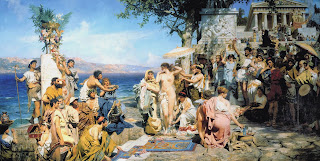There are two posts on this date.
32 YEARS SINCE THE MURDER OF PAVLOS BAKOYIANNIS
Like yesterday in 1986, Pavlos Bakoyiannis the Greek politician and magazine publisher was gunned down and murdered outside his office building in Athens, by the terrorist organization 17th November.
Bakoyiannis was born in 1935 in a small village in Evritania, central Greece. His father was the village priest. He studied in Athens and Munich and worked for Deutsche Welle as a newscaster of their Greek language radio program.
The same year he married Theodora (Dora) Mitsotakis, the daughter of politician Konstantinos Mistotakis.
In 1982, he became the publisher of the magazine ENA. A few months before his death, in June 1989, he entered politics as an elected member of Parliament representing Evritania.
Dimitris Koufodinas, Irakles Kostaris and Alexander Yiotopoulos were sentenced to life imprisonment by the Athens court in December 2003.
Here is a photo of the Bakoyianni family:
PLEASE DO BE VACCINATED AGAINST COVID - 19 SO THAT YOUR BELOVED FAMILIES, FRIENDS, THE WORLD AND YOU WILL REMAIN HEALTHY AND SAFE.
GREEK GOURMET DISHES
GREEK BEEF SOUP
! kg (2 lb) beef, cut into bite-sized pieces
3 tbsp olive oil
3 carrots, scraped and sliced
3 celery stalks, threaded and sliced
2 onions, peeled and finely chopped
2 bay leaves
3 medium-sized potatoes, peeled and cubed
1 tbsp fresh thyme, chopped plus extra for serving
1 beef cube
Salt and pepper to taste
Juice of 1 lemon
Zest of 1 lemon
Sauté the carrots, celery, and onions in olive oil until the
onions turn translucent. Add the meat
and beef cube, taste and season with salt if necessary and pepper to taste. Add
the bay leaves and chopped thyme. Pour
in enough hot water to cover and simmer until the meat is almost tender. Add the potatoes, lemon juice and zest and
cook until the potatoes are tender. Discard the bay leaves.
Serve steaming hot, with a squeeze of lemon juice, a splash
of olive oil sprinkled with extra chopped thyme and don’t forget to accompany
it with crusty brown bread.
GREEK PEA AND POTATO STEW WITH
TOMATOES
420 g (16 oz) peas, peeled
120 ml (4 fl oz) olive oil
1 onion, peeled and chopped
2 spring onions, trimmed and finely sliced
2 carrots, scraped and sliced
2 potatoes, peeled and cubed
1 tbsp tomato paste
300 g (10 oz) ripe tomatoes, halved, seeded, grated skins
discarded
2 tbsp chopped fresh dill
Salt and freshly ground black pepper to taste
Sauté the onion and spring onions in half the olive oil
until the onions become transparent. Add
the carrots, potatoes, and tomato paste and cook for 2 minutes more.
Add the grated tomato tomatoes and enough hot water to just
cover. Bring to the boil and simmer for
15 minutes, without a lid, until the potatoes have softens a little.
Add th peas, fresh dill, and the remaining olive oil and
season with salt and pepper to taste..
Mix well, lower the heat and simmer for 10 minutes, until the peas are
soft and the loiquid has evaporated, they should only be left with olive oil.
Serve at room temperature with crumbled feta and crusty
brown bread.
VEAL WITH
LEMON SAUCE
1 – 1 ½ kg (2- 2¾ lb)
stewing veal, cut into portions
2 onions, peeled and chopped
2 cloves of garlic, peeled and minced
Juice of 3 lemons
½ cup of olive oil
Salt and freshly ground pepper to taste
2 tbsp fresh thyme chopped
Sauté the onions in olive oil until transparent, add the
meat and cook until brown. Pour in the
lemon juice and sprinkle with the minced garlic and season with salt and pepper
to taste. Cover with hot water to just
cover. Boil uncovered until the meat is tender and liquid has evaporated.
Serve sprinkled with chopped fresh thyme and creamy mashed
potatoes.
SALMON DISH
For topping;
¼ cup olive oil
Juice of 2 lemons
1 clove garlic, peeled and minced
1 tsp dried oregano
½ tsp red pepper flakes
1 cup cubed feta
1 cup halved cherry tomatoes
½ cup stoned and sliced Kalamata olives
¼ cup peeled and chopped cucumbers
¼ cup peeled and chopped onion
2 tbsp chopped dill
For salmon:
1 lemon, thinly sliced
1 onion, peeled and sliced
4 salmon fillets, boned and patted dry with kitchen paper
Salt and pepper to taste
Preheat oven to 180 C (350 F). In a large bowl, whisk olive oil, lemon juice, garlic, oregano and red pepper flakes. Season to taste and add the feta and toss to coat, cover and refrigerate for 10 minutes.
Roast the fish, Scatter the lemon and onion slices at the bottom of a large pyrex dish. Add the salmon fillets, skin down, season with salt and pepper, and bake until opaque and flaky, 18-20 minutes.
Meanwhile, prepare the topping. In a bowl with the feta add the tomatoes, olives, cucumbers and chopped dill, and toss gently to combine.
Serve the salmon with the lemon and onion slices and top with the feta mixture
PLEASE DO BE VACCINATED AGAINST COVID - 19 SO THAT YOUR BELOVED FAMILIES, FRIENDS, THE WORLD AND YOU WILL REMAIN HEALTHY AND SAFE.

















































